The New Tamid Torah
Tamid’s New Torah
On Rosh Hashanah, Sept. 21 at 10 AM we welcomed our New Torah into the life of our congregation. This process began in late 2014 and on June 4, 2017, the final two letters were written.The 304,805 letters on 65 pages of parchment started in Israel and was finished in New York. Thank you to supporters from all over the world who supported this new Torah. This has been an incredible journey for our congregation and the start of this new scroll is the start of a new chapter for our community.
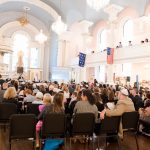 This is the first time that a new Torah is installed by our congregation at our house of worship, St. Paul’s Chapel, the oldest house of worship in New York City and where George Washington prayed on the day of his inauguration. “I believe the people who wrote the US Constitution and brought that document to life, who stood for religious freedom, would be very proud to know that in a much later generation, a Jewish congregation would install a new Torah, the equivalent of a Jewish Constitution, in that very same hall,” said our rabbi, Darren Levine.
This is the first time that a new Torah is installed by our congregation at our house of worship, St. Paul’s Chapel, the oldest house of worship in New York City and where George Washington prayed on the day of his inauguration. “I believe the people who wrote the US Constitution and brought that document to life, who stood for religious freedom, would be very proud to know that in a much later generation, a Jewish congregation would install a new Torah, the equivalent of a Jewish Constitution, in that very same hall,” said our rabbi, Darren Levine.
This is also a historic event for gender equality since this is the first Torah to be written by the hand of a female scribe for a Manhattan synagogue – something to be celebrated by the entire Jewish Community. Thank you to our friend and scribe, Julie Seltzer, for bringing us closer to Torah and for sharing your love of Judaism with us.
WATCH THIS 2-MIN VIDEO ABOUT THE CREATION OF OUR NEW TORAH
ON-GOING TORAH DEDICATION OPPORTUNITIES
Contributing to the writing of a Torah is a sacred opportunity and for many, a once in a lifetime moment. We invite you to name sections and parts of the Torah in honor of your loved ones. We would be happy to work with you to find the right dedication for your family. Please email Rabbi Darren Levine to speak about the creative ways to dedicate your section of Torah. Some suggestions:
- * In memory of parents and grandparents
- * A Bar/Bat Mitzvah Torah reading of long ago
- * A birth, baby naming, bris, bar mitzvah or wedding
- * Any major life event
- * Your child’s Bar/Bat Mitzvah Torah reading, future or present
CLICK HERE TO MAKE YOUR CONTRIBUTION TO THE NEW TORAH
RECOGNIZING YOUR TORAH DEDICATION
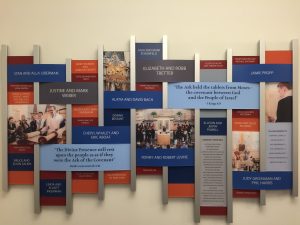 Honoring your dedication is an important part of this communal effort. We are honored to recognize your dedication with a brick on our Community Wall at Tamid with your family name or anonymously. The evergreen display that we use allows for brick sizes to match the level of your contribution.
Honoring your dedication is an important part of this communal effort. We are honored to recognize your dedication with a brick on our Community Wall at Tamid with your family name or anonymously. The evergreen display that we use allows for brick sizes to match the level of your contribution.
Jewish wisdom teaches that “one mitzvah encourages another mitzvah.” It is our mitzvah and our privilege to honor your generosity.
ABOUT OUR SCRIBE, JULIE SELTZER
Three years ago, Julie wrote the Torah for the Jewish Contemporary Museum in San Francisco to great acclaim. Watch her PBS interview on KQED. You are also invite to read her blog about writing the Tamid Torah below.
Please contact Christina Broussard at Tamid for more information and to book Julie to visit your community or organization (cbroussard @tamidnyc.org) or 646.360.0689.
Read/Share the Press Release about Julie and the New Tamid Torah
THANK YOU TO 450 MEMBERS AND FRIENDS
WHO WROTE A LETTER IN THE TORAH
 Thanks to everyone who wrote a letter in the Tamid Torah to fulfill the mitzvah ‘to write a Torah in your lifetime.’ In the Five books of Moses, we read, “now write for yourself this song and teach it to all the children of Israel. (Deut 31:19).” Anyone who writes a single letter in the Torah or enables the Torah to be written through his/her support, fulfills this holy obligation.
Thanks to everyone who wrote a letter in the Tamid Torah to fulfill the mitzvah ‘to write a Torah in your lifetime.’ In the Five books of Moses, we read, “now write for yourself this song and teach it to all the children of Israel. (Deut 31:19).” Anyone who writes a single letter in the Torah or enables the Torah to be written through his/her support, fulfills this holy obligation.
Thank you to many Tamid families who hosted Letter Writing Gatherings at your homes!
SCROLL AND READ! TORAH BLOG ENTRIES BY JULIE SELTZER, SCRIBE
#3 WRITING TORAH AND CREATING SPACE
By Julie Seltzer, Tamid Torah Scribe
Dear Tamid Friends,
I’m writing you from Mitzpe Ramon in the Negev Desert, where my Torah writing studio and home are located. The desert has always attracted me because of its vastness and potential for spiritual solitude. Mitzpe Ramon offers this kind of deep tranquility by the very nature of its location: the town sits on the rim of a large desert crater (machtesh), formed by thousands of years of erosion.
Many artists and writers are drawn to this town because of the psychological spaciousness it provides, helping to focus the mind and the spirit. For writers of Torah, there is an ancient practice to help focus the mind which is still used today by most scribes which is to immerse in the mikveh (ritual bath).
Dunking in the Mikveh is practiced at times of transition. We associate ritual immersion perhaps primarily with converting to Judaism, or in traditional circles, a woman’s monthly visit. But dunking in the Mikveh is a way to mark any kind of transition; the physical transformational energy of the water assists an internal, or spiritual transition.
Torah writing also has its associations with Mikveh immersion. While it is not a requirement to go to the Mikveh, it is recommended not to maintain “purity” in proximity to the Torah; rather, it is to help propel the scribe into a spiritually-ready state. Of course, the Mikveh is just one way to get there. I’ve been thinking a lot about this ‘state-of-spiritual-readiness,” and what I can do to help myself enter that space of presence, calm, and focus that is needed for writing the Tamid Torah.
Here in Mitzpe Ramon where I live and work, I think of the deep crater on my horizon as a mikveh of sorts. When I am inside it, and I look up at the rock walls surrounding me, I feel like I’m inside of a giant Mikveh, albeit without the water. The crater is a magical pool of rock swirling with pinks and yellows and purples. The silence is palpable, or to use a famous bible quote, the silence is actually a sound, a “kol dmama daka: a still, small, voice.” This was the dunk I took before starting to write the Tamid Torah, knowing that I’d be writing here in this part of Israel which is close to the place the Torah was first written. My immersion into the depths of the crater is one of my own mikveh experiences – the leap I periodically take to help return me to that place of readiness.
I’ve now completed 11 out of 62 sheets of the Tamid Torah. It’s a great privilege to be engaged in this sacred work and I look forward to sharing it with you in person this Fall. I’ll be joining you for Yom Kippur in New York at the 9/11 Chapel and I look forward to meeting you and sharing the work with you.
Shabbat Shalom,
Julie
#2 TAMID IN THE TORAH!
By Julie Seltzer, Tamid Torah Scribe
I am thrilled to report that I have completed three pages of the new Tamid Torah and am 1/20th of the way complete. You might think that I would start writing the Torah with the first words of the first book, but I chose a different place to begin. When I began writing last month, the weekly Torah portion Tetzaveh from the Book of Exodus was the reading of the week. Seemed like a good place to begin. But in addition to the timeliness of Tetzaveh, I started here because the word “tamid” appears with remarkable frequency in this portion, more than anywhere else in the Torah text.
 The most well-known example of the word tamid is in the context of the Ner Tamid (center words at right), what is often translated as the “Eternal Lamp.” Some synagogue spaces have a lamp with a constant glow that rests over the ark. In modern Hebrew, the word “tamid” does in mean “always.” Biblically, however, there is a debate as to its meaning. Does tamid mean “eternal/constant/always,” or does it mean “regular/habitual?” This latter suggestion is especially attractive if we consider the use of the word tamid in the context of the priest’s clothing. The text says that the priest’s holy garments were on him “tamid” but it would have been unlikely And so, instead of a lamp was always on, the Torah might be talking about a lamp which was turned on with certain regularity: say, each and every night.
The most well-known example of the word tamid is in the context of the Ner Tamid (center words at right), what is often translated as the “Eternal Lamp.” Some synagogue spaces have a lamp with a constant glow that rests over the ark. In modern Hebrew, the word “tamid” does in mean “always.” Biblically, however, there is a debate as to its meaning. Does tamid mean “eternal/constant/always,” or does it mean “regular/habitual?” This latter suggestion is especially attractive if we consider the use of the word tamid in the context of the priest’s clothing. The text says that the priest’s holy garments were on him “tamid” but it would have been unlikely And so, instead of a lamp was always on, the Torah might be talking about a lamp which was turned on with certain regularity: say, each and every night.
 I like the idea of tamid meaning “regularly”, especially when thinking about spiritual and community involvement. Can we ever expect something to *always* be the case? However, if we commit to returning to certain rituals and certain community events with regularity, we commit ourselves to a process. We do not experience the same thing every time we perform this “habit,” or “ritual,” but we do begin to learn a lot about ourselves through the process of returning time and again to the activity. I believe this is part of why we read the Torah text year after year: we get to see how we and the world at large have changed and how our perspective has shifted. Although the text is the same, the meaning is so very different from year to year, from person to person, from generation to generation (the above picture is one small column of the new Torah).
I like the idea of tamid meaning “regularly”, especially when thinking about spiritual and community involvement. Can we ever expect something to *always* be the case? However, if we commit to returning to certain rituals and certain community events with regularity, we commit ourselves to a process. We do not experience the same thing every time we perform this “habit,” or “ritual,” but we do begin to learn a lot about ourselves through the process of returning time and again to the activity. I believe this is part of why we read the Torah text year after year: we get to see how we and the world at large have changed and how our perspective has shifted. Although the text is the same, the meaning is so very different from year to year, from person to person, from generation to generation (the above picture is one small column of the new Torah).
The same is true for the process of writing Torah. It requires a certain regularity, a certain commitment. In speaking of the spiritual process that the writing demands, I most often use the word “hatmada” which comes from the same linguistic root as tamid. Hatmada suggests persistence; diligence; perseverance. The spiritual process, at the heart of it, is sticking with the task. The writing itself is a ritual in the most basic sense of the word, one that teaches perseverance and commitment, tamid.
#1 READY, SET . . .!
By Julie Seltzer, Tamid Torah Scribe
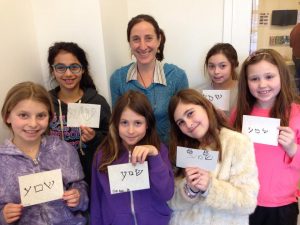 These last few weeks, since meeting Rabbi Levine and some of the Tamid students back in early February, have been devoted to getting ready. For what, you ask? If you haven’t yet heard, I will be writing a Torah with the Tamid community over the next 2 1/2 years. Each month, I’ll share a little about the Torah, the process, and the progress. Though very few of us have yet met in person, I like that you are out there reading this, on this journey with me. And I’m looking forward to meeting when I visit for the holidays next fall. This month was devoted to getting ready to write, and I’ll share with you two elements of my preparations: acquiring parchment, and buying a new scribe table. Nothing is ever as simple as it seems, here in Israel…
These last few weeks, since meeting Rabbi Levine and some of the Tamid students back in early February, have been devoted to getting ready. For what, you ask? If you haven’t yet heard, I will be writing a Torah with the Tamid community over the next 2 1/2 years. Each month, I’ll share a little about the Torah, the process, and the progress. Though very few of us have yet met in person, I like that you are out there reading this, on this journey with me. And I’m looking forward to meeting when I visit for the holidays next fall. This month was devoted to getting ready to write, and I’ll share with you two elements of my preparations: acquiring parchment, and buying a new scribe table. Nothing is ever as simple as it seems, here in Israel…
PARCHMENT: Before writing, I would need something to write on. Torahs are written on animal parchment, and there are special stores, located mostly in Jerusalem, that sell parchment and other supplies such as ink and feathers.
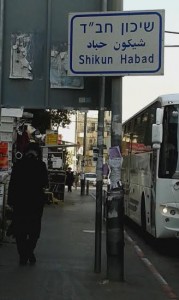 The first time I went to the supply store I now frequent, I’d never stepped foot in the Ultra-Orthodox neighborhood it’s located in. On that first trip several years back, dressed in my “religious outfit” (long skirt, long sleeve shirt: basically, no flesh showing other than face and hands), I wandered around looking for 12 Elqana Street. When I passed Hannah Street, I knew I must be close: in Israel, the streets are thematically clustered. Hannah, the biblical character who prays with all her heart to conceive a child, is married to Elkana. So when I passed Hannah Street, I knew I must be close to Elqana and to my destination.
The first time I went to the supply store I now frequent, I’d never stepped foot in the Ultra-Orthodox neighborhood it’s located in. On that first trip several years back, dressed in my “religious outfit” (long skirt, long sleeve shirt: basically, no flesh showing other than face and hands), I wandered around looking for 12 Elqana Street. When I passed Hannah Street, I knew I must be close: in Israel, the streets are thematically clustered. Hannah, the biblical character who prays with all her heart to conceive a child, is married to Elkana. So when I passed Hannah Street, I knew I must be close to Elqana and to my destination. 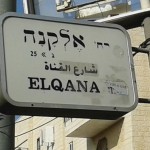
Since then, I and the other small handful of female scribes have developed a relationship with the owners of this store. They are a Yiddish-speaking family, ultra-Orthodox, no internet. The stereotype would lead one to believe that they would shoo us out of the store at first glance and first chance, and certainly once they knew we were the ones writing Torah and not our husbands. However, they have been incredibly warm and friendly, even supportive and curious about us.
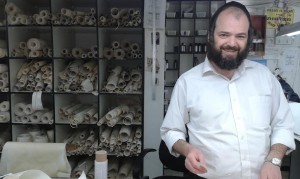 Two weeks ago, just after returning home to Israel from a trip to the States, I went to the store to buy the first pieces of parchment for the Tamid Torah. Meir, one of the sons, is pictured here in this photograph. He and his brother operate the store, and their mother is often there as well. At first, when my female colleagues and I showed up to buy parchment and other supplies, they probably assumed that we were buying for our husbands. We didn’t say otherwise. I referred to this as the “Don’t Ask/Don’t Tell” policy. But this was probably a misnomer: it’s not that we were all silently agreeing to a secret that everyone knew but didn’t name; it’s simply that it didn’t occur to them that women would be writing.
Two weeks ago, just after returning home to Israel from a trip to the States, I went to the store to buy the first pieces of parchment for the Tamid Torah. Meir, one of the sons, is pictured here in this photograph. He and his brother operate the store, and their mother is often there as well. At first, when my female colleagues and I showed up to buy parchment and other supplies, they probably assumed that we were buying for our husbands. We didn’t say otherwise. I referred to this as the “Don’t Ask/Don’t Tell” policy. But this was probably a misnomer: it’s not that we were all silently agreeing to a secret that everyone knew but didn’t name; it’s simply that it didn’t occur to them that women would be writing.
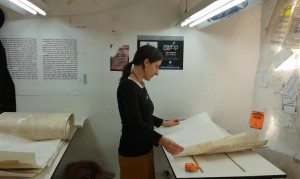 That is, until we started showing up with some frequency, often together. It was last spring, when my colleagues Shoshana, Hannah, and I all went in to buy parchment for a collective Torah, that something must have clicked in Meir’s mind, and he asked point blank: “Who is writing – you?” We answered somewhat meekly, “yes.” Part of me was nervous, though he’d shown nothing but kindness, that he would kick us all out of the store, or simply refuse to sell to us for moral or halachic reasons. But he didn’t blink an eye. Now, Meir even speaks the language, asking if this new Torah I’ll be writing is for a “Reformi Community” (in Israel, this is a catch-all term for all liberal Judaism).
That is, until we started showing up with some frequency, often together. It was last spring, when my colleagues Shoshana, Hannah, and I all went in to buy parchment for a collective Torah, that something must have clicked in Meir’s mind, and he asked point blank: “Who is writing – you?” We answered somewhat meekly, “yes.” Part of me was nervous, though he’d shown nothing but kindness, that he would kick us all out of the store, or simply refuse to sell to us for moral or halachic reasons. But he didn’t blink an eye. Now, Meir even speaks the language, asking if this new Torah I’ll be writing is for a “Reformi Community” (in Israel, this is a catch-all term for all liberal Judaism).
Choosing parchment (klaf in Hebrew) is not a simple endeavor. Not all pieces are the same – in fact, no two pieces are the same, because they are made of cow skin – and every cow, like every person, is different. The key is to find pieces that will yield the best writing. Though tradition tells us that Torahs are “black fire on white fire,” parchment is not actually white. Most pieces have the cow’s brown spots, or even spine mark. Here I am in the store, carefully selecting parchment [picture of me].
 WRITING TABLE: Now that I had something to write on, I needed something to rest it on. I decided that before beginning this new Torah, my office would get a little makeover. I was going to purchase a new writing table, one made especially for scribes, which I will inaugurate with the first words of the Tamid Torah. Making this purchase proved to be another example of “Don’t Ask Don’t Tell,” or, similarly, a version of simply not knowing that women write. I placed a phone call to the company, saying I was interested in buying a scribe table. We spoke in Hebrew, which has different words for the singular and plural forms of “you.”
WRITING TABLE: Now that I had something to write on, I needed something to rest it on. I decided that before beginning this new Torah, my office would get a little makeover. I was going to purchase a new writing table, one made especially for scribes, which I will inaugurate with the first words of the Tamid Torah. Making this purchase proved to be another example of “Don’t Ask Don’t Tell,” or, similarly, a version of simply not knowing that women write. I placed a phone call to the company, saying I was interested in buying a scribe table. We spoke in Hebrew, which has different words for the singular and plural forms of “you.”
After placing the order and asking for delivery, the man selling the table asked:
“Where do you (plural) live?”
“I (singular) live in Mitzpe Ramon,” I answered.
“What’s your (plural) street?”
“My (singular) street is Nahal Grofit.”
“Do you (plural) have an apartment number?”
It was as if he literally could not hear me – could not conceive of the possibility that there was no husband, no man who is the scribe. Not because they suspected that I was writing and didn’t want to sell to me because of that, but that the possibility did not even occur to them. Someone later explained that using the plural form even when speaking to an individual is a common way for ultra-Orthodox men to address women they do not know, so as to avoid familiarity, so perhaps this came into play as well. Still, no one asked and I did not offer who’d be using the table.
Stay tuned: Next month, I’ll share a picture of the Torah in progress, and I’ll tell you all about the shared studio space I work in.
Shabbat Shalom,
Julie
